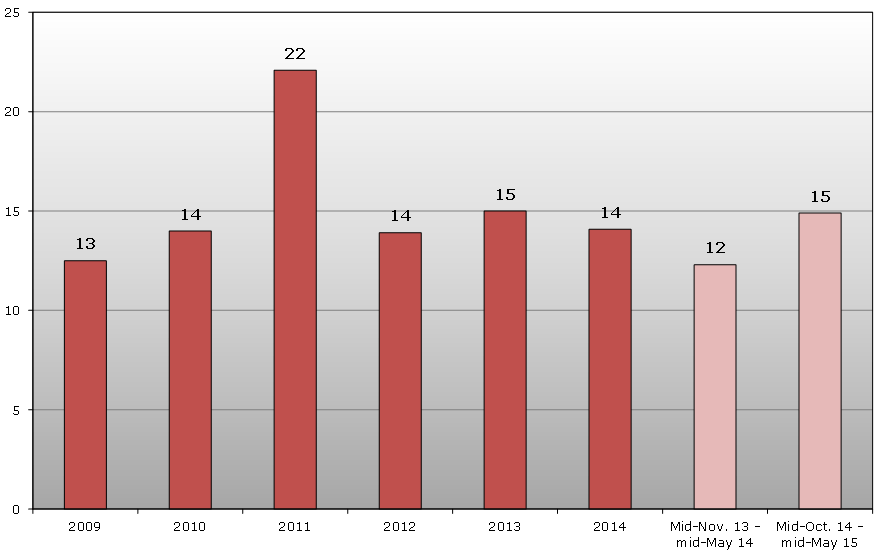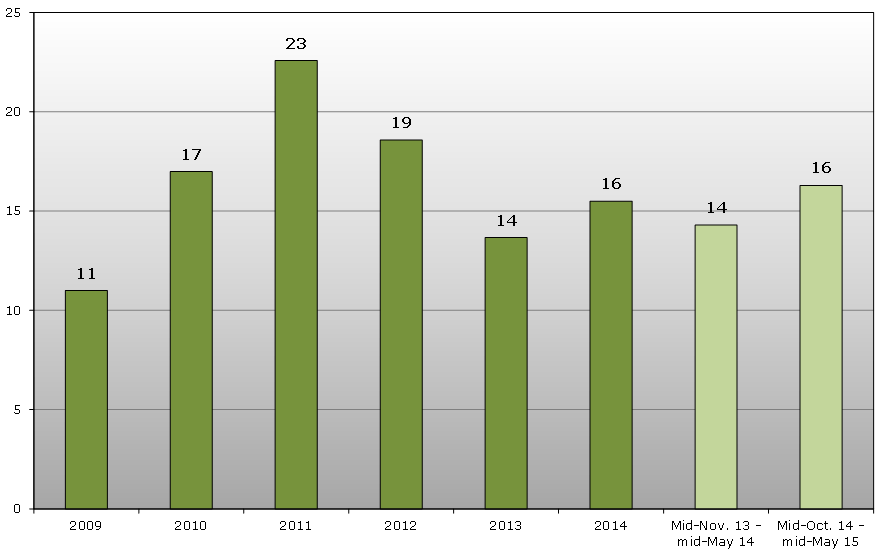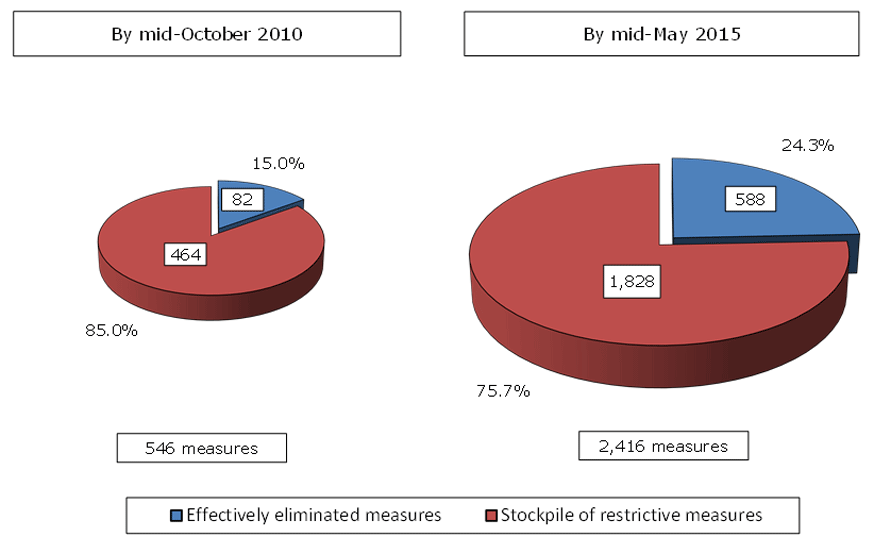News
Increasing stockpile of trade-restrictive measures “a cause for concern”

The increasing stockpile of trade-restrictive measures introduced by WTO members remains a cause for concern, and continued vigilance is required, according to the latest report on trade-related developments presented on 23 July 2015 by WTO Director General Roberto Azevêdo.
On the positive side, an increasing number of trade-liberalizing measures, such as tariff-cutting measures, were adopted by WTO members during the period under review, 16 October 2014 to 15 May 2015.
The report confirms that WTO Members continue to show some restraint in introducing new trade-restrictive measures with the introduction of such measures (excluding trade remedies) relatively stable since 2012. During the period under review, 104 new trade-restrictive measures were put in place – an average of around 15 new measures per month.
Nevertheless, the slow pace of removal of previous restrictions means that the overall stock of restrictive measures is continuing to increase. Of the 2,416 restrictions (including trade remedies) recorded by the monitoring exercise since October 2008, only 588 have been removed. In other words, the total number of those restrictive measures still in place currently stands at 1,828 – up by over 12% compared to the last report. The addition of new restrictive measures, combined with a slow removal rate, remains a persistent concern. With the share of removals of total restrictive measures still under 25%, the longer-term trend in the number of trade-restrictive measures remains an area where continued vigilance is required.
More encouragingly, WTO Members continued to adopt measures aimed at facilitating trade, both temporary and permanent in nature. Members implemented 114 new trade-liberalizing measures during the period under review – an average of more than 16 measures per month. When counted without trade-remedy actions, WTO Members have adopted more liberalizing trade measures than restrictive measures since the end of 2013.
Also, in the area of trade remedies, a slight deceleration has been observed in the number of initiations of anti-dumping investigations during the period under review. Initiations of countervailing investigations and safeguard investigations have also declined recently.
The broader international economic context also supports the need for continuing vigilance and action. Trends in world trade and output have remained mixed since the last monitoring report, as merchandise trade volumes and GDP growth picked up in the second half of 2014 but appear to have slowed in the first quarter of 2015. Economic activity remained uneven across countries as the United States (US) and China slowed in Q1 while growth in the euro area and Japan picked up. Plunging oil prices and strong exchange rate fluctuations – including an appreciation of the U.S. dollar and a depreciation of the Euro – generated uncertainty to the economic outlook. Lower prices for oil and other primary commodities were expected to provide a boost to importing economies, but reduced export revenues weighed heavily on commodity exporters. In light of these developments, the Secretariat’s most recent forecast (14 April 2015) predicted a continued moderate expansion of trade in 2015 and 2016, although the pace of recovery was expected to remain below historical averages. According to this forecast, growth in the volume of world merchandise trade should increase from 2.8% in 2014 to 3.3% in 2015 and further to 4.0% in 2016.
This report shows that WTO Members introduced 75 new general economic support measures. The main beneficiaries were selected industries in the manufacturing sector, activities related to the agricultural sector and a number of programmes to assist SMEs. A variety of financial aid schemes appear by design to seek to encourage or boost exports while others identify conservation and the environment as overall objectives. A significant number of programmes which seek to eliminate or reduce subsidy schemes for gasoline and other fuels were identified during the period under review.
From transparency and systemic points of view, important developments took place in the WTO’s TBT and SPS Committees. The SPS Committee has witnessed a significant growth in notifications from developing countries leading to the highest number of notifications to date. An increase in the number of notifications does not, however, automatically imply greater use of measures taken for protectionist purposes. Another noteworthy development was a significant increase in the number of new specific trade concerns (STCs) raised in the TBT Committee.
A number of recent policy developments in services were recorded during the review period. These include reforms of the insurance and pension sectors and easing of the rules on foreign investment in the construction and railway transportation sectors in India, as well as the lifting of restrictions on foreign investment in several service sectors in China. Also noteworthy is the amendment of the Russian Law on Foreign Investment in Strategic Companies; several important reforms in the audio-visual and ICT sectors by Argentina, Belgium, Mexico, Madagascar, Myanmar, Poland, the Russian Federation, Sierra Leone and the United States (US); and also in financial services by China, India, Myanmar and the Philippines.
The overall assessment of this monitoring report is that the continuing increase in the stock of new trade-restrictive measures recorded since 2008 remains of concern in the context of an uncertain global economic outlook. WTO Members – individually and collectively – must show leadership and reinforced determination towards eliminating existing trade restrictions and refrain from implementing new ones.
The multilateral trading system has proven its usefulness in providing a predictable and transparent framework governing trade between nations and in helping Members resist protectionist pressures as a response to the global economic and financial crisis and thereafter. The role of the multilateral trading system in providing a stable, predictable and transparent trading environment should be kept in mind as Members prepare for the WTO’s MC10 in Nairobi in December. Decisive progress in eliminating remaining trade-restrictive measures combined with further multilateral trade liberalization would be a powerful policy response.
Key findings
104 new trade-restrictive measures (excluding trade remedy measures) were put in place in the reporting period 16 October 2014 to 15 May 2015 – an average of around 15 new measures per month.
This monthly rate has remained relatively stable since 2012, though the overall stock of measures nevertheless continues to rise.
Of the 2,416 measures recorded since October 2008, less than 25% have been removed, leaving the stock of restrictive measures still in place at 1,828. This represents an increase of 12% compared to the last report.
This remains a cause for concern and continued vigilance is required from WTO members.
More encouragingly, WTO Members have adopted more trade-liberalizing measures (excluding trade remedy actions) than trade-restrictive measures since the end of 2013. Continuing this trend, during the period under review, WTO Members implemented 114 new trade-liberalizing measures – an average of more than 16 measures per month.
The broader international economic context supports the need for vigilance and action with regard to trade-restrictive measures. According to the WTO’s most recent forecast (14 April 2015), growth in the volume of world merchandise trade should increase from 2.8% in 2014 to 3.3% in 2015 and further to 4.0% in 2016, but remaining below historical averages.
The multilateral trading system has proven its usefulness in providing a predictable and transparent framework governing trade between nations and in helping Members resist protectionist pressures as a response to the global economic and financial crisis and thereafter.
This role in providing a stable, predictable and transparent trading environment should be kept in mind as Members prepare for the WTO’s tenth Ministerial Conference in Nairobi in December.
Trade-restrictive measures, not including trade remedies (Average per month)

Trade-facilitating measures, not including trade remedies (Average per month)

Stockpile of restrictive measures1





